Target Information
| Target General Information | Top | |||||
|---|---|---|---|---|---|---|
| Target ID |
T47101
(Former ID: TTDC00024)
|
|||||
| Target Name |
Fibroblast growth factor receptor 1 (FGFR1)
|
|||||
| Synonyms |
c-fgr; bFGF-R-1; bFGF-R; N-sam; HBGFR; Fms-like tyrosine kinase 2; FLT2; FLT-2; FLG; FGFR-1; FGFBR; CEK; CD331 antigen; CD331; Basic fibroblast growth factor receptor 1; BFGFR
Click to Show/Hide
|
|||||
| Gene Name |
FGFR1
|
|||||
| Target Type |
Successful target
|
[1] | ||||
| Disease | [+] 4 Target-related Diseases | + | ||||
| 1 | Colorectal cancer [ICD-11: 2B91] | |||||
| 2 | Idiopathic interstitial pneumonitis [ICD-11: CB03] | |||||
| 3 | Liver cancer [ICD-11: 2C12] | |||||
| 4 | Thrombocytopenia [ICD-11: 3B64] | |||||
| Function |
Required for normal mesoderm patterning and correct axial organization during embryonic development, normal skeletogenesis and normal development of the gonadotropin-releasing hormone (GnRH) neuronal system. Phosphorylates PLCG1, FRS2, GAB1 and SHB. Ligand binding leads to the activation of several signaling cascades. Activation of PLCG1 leads to the production of the cellular signaling molecules diacylglycerol and inositol 1,4,5-trisphosphate. Phosphorylation of FRS2 triggers recruitment of GRB2, GAB1, PIK3R1 and SOS1, and mediates activation of RAS, MAPK1/ERK2, MAPK3/ERK1 and the MAP kinase signaling pathway, as well as of the AKT1 signaling pathway. Promotes phosphorylation of SHC1, STAT1 and PTPN11/SHP2. In the nucleus, enhances RPS6KA1 and CREB1 activity and contributes to the regulation of transcription. FGFR1 signaling is down-regulated by IL17RD/SEF, and by FGFR1 ubiquitination, internalization and degradation. Tyrosine-protein kinase that acts as cell-surface receptor for fibroblast growth factors and plays an essential role in the regulation of embryonic development, cell proliferation, differentiation and migration.
Click to Show/Hide
|
|||||
| BioChemical Class |
Kinase
|
|||||
| UniProt ID | ||||||
| EC Number |
EC 2.7.10.1
|
|||||
| Sequence |
MWSWKCLLFWAVLVTATLCTARPSPTLPEQAQPWGAPVEVESFLVHPGDLLQLRCRLRDD
VQSINWLRDGVQLAESNRTRITGEEVEVQDSVPADSGLYACVTSSPSGSDTTYFSVNVSD ALPSSEDDDDDDDSSSEEKETDNTKPNRMPVAPYWTSPEKMEKKLHAVPAAKTVKFKCPS SGTPNPTLRWLKNGKEFKPDHRIGGYKVRYATWSIIMDSVVPSDKGNYTCIVENEYGSIN HTYQLDVVERSPHRPILQAGLPANKTVALGSNVEFMCKVYSDPQPHIQWLKHIEVNGSKI GPDNLPYVQILKTAGVNTTDKEMEVLHLRNVSFEDAGEYTCLAGNSIGLSHHSAWLTVLE ALEERPAVMTSPLYLEIIIYCTGAFLISCMVGSVIVYKMKSGTKKSDFHSQMAVHKLAKS IPLRRQVTVSADSSASMNSGVLLVRPSRLSSSGTPMLAGVSEYELPEDPRWELPRDRLVL GKPLGEGCFGQVVLAEAIGLDKDKPNRVTKVAVKMLKSDATEKDLSDLISEMEMMKMIGK HKNIINLLGACTQDGPLYVIVEYASKGNLREYLQARRPPGLEYCYNPSHNPEEQLSSKDL VSCAYQVARGMEYLASKKCIHRDLAARNVLVTEDNVMKIADFGLARDIHHIDYYKKTTNG RLPVKWMAPEALFDRIYTHQSDVWSFGVLLWEIFTLGGSPYPGVPVEELFKLLKEGHRMD KPSNCTNELYMMMRDCWHAVPSQRPTFKQLVEDLDRIVALTSNQEYLDLSMPLDQYSPSF PDTRSSTCSSGEDSVFSHEPLPEEPCLPRHPAQLANGGLKRR Click to Show/Hide
|
|||||
| 3D Structure | Click to Show 3D Structure of This Target | AlphaFold | ||||
| HIT2.0 ID | T55JB4 | |||||
| Drugs and Modes of Action | Top | |||||
|---|---|---|---|---|---|---|
| Approved Drug(s) | [+] 3 Approved Drugs | + | ||||
| 1 | Intedanib | Drug Info | Approved | Colorectal cancer | [2] | |
| 2 | Pemigatinib | Drug Info | Approved | Cholangiocarcinoma | [3] | |
| 3 | Romiplostim | Drug Info | Approved | Thrombocytopenia | [4], [5] | |
| Clinical Trial Drug(s) | [+] 13 Clinical Trial Drugs | + | ||||
| 1 | ARQ-087 | Drug Info | Phase 3 | Intrahepatic cholangiocarcinoma | [6] | |
| 2 | E-3810 | Drug Info | Phase 3 | Solid tumour/cancer | [7], [8] | |
| 3 | Rosiglitazone + metformin | Drug Info | Phase 3 | Diabetic complication | [9] | |
| 4 | Sulfatinib | Drug Info | Phase 3 | Neuroendocrine cancer | [10] | |
| 5 | AZD4547 | Drug Info | Phase 2/3 | Solid tumour/cancer | [11], [12] | |
| 6 | AM-001 | Drug Info | Phase 2 | Dermatological disease | [13] | |
| 7 | Debio 1347 | Drug Info | Phase 2 | Solid tumour/cancer | [14] | |
| 8 | FGF-1 | Drug Info | Phase 2 | Coronary heart disease | [15] | |
| 9 | FP-1039 | Drug Info | Phase 2 | Endometrial cancer | [16] | |
| 10 | MK-3655 | Drug Info | Phase 2 | Non-alcoholic steatohepatitis | [17] | |
| 11 | MK-2461 | Drug Info | Phase 1/2 | Alzheimer disease | [18] | |
| 12 | KW-2449 | Drug Info | Phase 1 | Acute myeloid leukaemia | [19], [20] | |
| 13 | NGM313 | Drug Info | Phase 1 | Type-2 diabetes | [21] | |
| Preclinical Drug(s) | [+] 1 Preclinical Drugs | + | ||||
| 1 | BMS-695735 | Drug Info | Preclinical | Solid tumour/cancer | [22] | |
| Discontinued Drug(s) | [+] 1 Discontinued Drugs | + | ||||
| 1 | PD-0183812 | Drug Info | Terminated | Retinoblastoma | [23] | |
| Mode of Action | [+] 5 Modes of Action | + | ||||
| Modulator | [+] 3 Modulator drugs | + | ||||
| 1 | Intedanib | Drug Info | [2] | |||
| 2 | AZD4547 | Drug Info | [29] | |||
| 3 | NGM313 | Drug Info | [21] | |||
| Inhibitor | [+] 27 Inhibitor drugs | + | ||||
| 1 | Pemigatinib | Drug Info | [3] | |||
| 2 | Romiplostim | Drug Info | [1] | |||
| 3 | ARQ-087 | Drug Info | [24] | |||
| 4 | E-3810 | Drug Info | [25] | |||
| 5 | Rosiglitazone + metformin | Drug Info | [26], [27] | |||
| 6 | Sulfatinib | Drug Info | [28] | |||
| 7 | Debio 1347 | Drug Info | [6] | |||
| 8 | MK-2461 | Drug Info | [18] | |||
| 9 | BMS-695735 | Drug Info | [34] | |||
| 10 | PD-0183812 | Drug Info | [35] | |||
| 11 | 2-(1H-indazol-3-yl)-1H-benzo[d]imidazole | Drug Info | [36] | |||
| 12 | 3-(3-methoxybenzyl)-1H-pyrrolo[2,3-b]pyridine | Drug Info | [37] | |||
| 13 | 3-Benzimidazol-2-ylhydroquinolin-2-one | Drug Info | [38] | |||
| 14 | AAL-993 | Drug Info | [1] | |||
| 15 | ACTB-1003 | Drug Info | [24] | |||
| 16 | HKI-9924129 | Drug Info | [39] | |||
| 17 | NP-506 | Drug Info | [40] | |||
| 18 | PD-0166326 | Drug Info | [39] | |||
| 19 | PD-0173952 | Drug Info | [39] | |||
| 20 | PD-0173955 | Drug Info | [39] | |||
| 21 | PD-0173956 | Drug Info | [39] | |||
| 22 | PD-0173958 | Drug Info | [39] | |||
| 23 | PD-0179483 | Drug Info | [39] | |||
| 24 | PMID22765894C8h | Drug Info | [41] | |||
| 25 | PMID24900538C2c | Drug Info | [42] | |||
| 26 | PMID26080733C7r | Drug Info | [43] | |||
| 27 | Ro-4396686 | Drug Info | [44] | |||
| Antagonist | [+] 2 Antagonist drugs | + | ||||
| 1 | AM-001 | Drug Info | [30] | |||
| 2 | FP-1039 | Drug Info | [32] | |||
| Binder | [+] 1 Binder drugs | + | ||||
| 1 | FGF-1 | Drug Info | [31] | |||
| Agonist | [+] 1 Agonist drugs | + | ||||
| 1 | SAR-106881 | Drug Info | [24] | |||
| Cell-based Target Expression Variations | Top | |||||
|---|---|---|---|---|---|---|
| Cell-based Target Expression Variations | ||||||
| Drug Binding Sites of Target | Top | |||||
|---|---|---|---|---|---|---|
| Ligand Name: Pemigatinib | Ligand Info | |||||
| Structure Description | Crystal structure of FGFR1 kinase domain with Pemigatinib | PDB:7WCL | ||||
| Method | X-ray diffraction | Resolution | 2.50 Å | Mutation | Yes | [45] |
| PDB Sequence |
GVSEYELPED
468 PRWELPRDRL478 VLGKPLGEGC488 FGQVVLAEAI498 GLDKDKPNRV508 TKVAVKMLKS 518 DATEKDLSDL528 ISEMEMMKMI538 GKHKNIINLL548 GACTQDGPLY558 VIVEYASKGN 568 LREYLQARRP578 PGLEYSYNPS588 HNPEEQLSSK598 DLVSCAYQVA608 RGMEYLASKK 618 CIHRDLAARN628 VLVTEDNVMK638 IADFGLARDI648 HHIDYYKKTT658 NGRLPVKWMA 668 PEALFDRIYT678 HQSDVWSFGV688 LLWEIFTLGG698 SPYPGVPVEE708 LFKLLKEGHR 718 MDKPSNCTNE728 LYMMMRDCWH738 AVPSQRPTFK748 QLVEDLDRIV758 ALTSNQ |
|||||
|
|
LYS482
3.457
PRO483
4.496
LEU484
3.530
GLY485
4.894
VAL492
3.525
ALA512
3.569
VAL513
4.537
LYS514
3.143
LEU528
4.864
GLU531
3.405
MET535
3.862
ILE545
3.786
VAL559
3.703
|
|||||
| Ligand Name: Erdafitinib | Ligand Info | |||||
| Structure Description | FIBROBLAST GROWTH FACTOR RECEPTOR 1 IN COMPLEX WITH JNJ-4275693 | PDB:5EW8 | ||||
| Method | X-ray diffraction | Resolution | 1.63 Å | Mutation | No | [46] |
| PDB Sequence |
ELPEDPRWEL
473 PRDRLVLGKP483 LGEGAFGQVV493 LAEAIGLDKD503 KPNRVTKVAV513 KMLKSDATEK 523 DLSDLISEME533 MMKMIGKHKN543 IINLLGACTQ553 DGPLYVIVEY563 ASKGNLREYL 573 QARRPPGEEQ594 LSSKDLVSCA604 YQVARGMEYL614 ASKKCIHRDL624 AARNVLVTED 634 NVMKIADFGL644 ARDIHHIDYY654 KKTTNGRLPV664 KWMAPEALFD674 RIYTHQSDVW 684 SFGVLLWEIF694 TLGGSPYPGV704 PVEELFKLLK714 EGHRMDKPSN724 CTNELYMMMR 734 DCWHAVPSQR744 PTFKQLVEDL754 DRIVALTSNQ764 E
|
|||||
|
|
LEU484
2.711
GLY485
4.374
VAL492
3.100
ALA512
3.278
LYS514
3.348
LEU528
4.048
GLU531
2.611
MET535
2.920
ILE545
2.719
ASN546
4.597
LEU547
4.972
VAL559
3.038
VAL561
2.893
GLU562
2.282
TYR563
3.047
|
|||||
| Click to View More Binding Site Information of This Target with Different Ligands | ||||||
| Different Human System Profiles of Target | Top |
|---|---|
|
Human Similarity Proteins
of target is determined by comparing the sequence similarity of all human proteins with the target based on BLAST. The similarity proteins for a target are defined as the proteins with E-value < 0.005 and outside the protein families of the target.
A target that has fewer human similarity proteins outside its family is commonly regarded to possess a greater capacity to avoid undesired interactions and thus increase the possibility of finding successful drugs
(Brief Bioinform, 21: 649-662, 2020).
Human Tissue Distribution
of target is determined from a proteomics study that quantified more than 12,000 genes across 32 normal human tissues. Tissue Specificity (TS) score was used to define the enrichment of target across tissues.
The distribution of targets among different tissues or organs need to be taken into consideration when assessing the target druggability, as it is generally accepted that the wider the target distribution, the greater the concern over potential adverse effects
(Nat Rev Drug Discov, 20: 64-81, 2021).
Human Pathway Affiliation
of target is determined by the life-essential pathways provided on KEGG database. The target-affiliated pathways were defined based on the following two criteria (a) the pathways of the studied target should be life-essential for both healthy individuals and patients, and (b) the studied target should occupy an upstream position in the pathways and therefore had the ability to regulate biological function.
Targets involved in a fewer pathways have greater likelihood to be successfully developed, while those associated with more human pathways increase the chance of undesirable interferences with other human processes
(Pharmacol Rev, 58: 259-279, 2006).
Biological Network Descriptors
of target is determined based on a human protein-protein interactions (PPI) network consisting of 9,309 proteins and 52,713 PPIs, which were with a high confidence score of ≥ 0.95 collected from STRING database.
The network properties of targets based on protein-protein interactions (PPIs) have been widely adopted for the assessment of target’s druggability. Proteins with high node degree tend to have a high impact on network function through multiple interactions, while proteins with high betweenness centrality are regarded to be central for communication in interaction networks and regulate the flow of signaling information
(Front Pharmacol, 9, 1245, 2018;
Curr Opin Struct Biol. 44:134-142, 2017).
Human Similarity Proteins
Human Tissue Distribution
Human Pathway Affiliation
Biological Network Descriptors
|
|
|
Note:
If a protein has TS (tissue specficity) scores at least in one tissue >= 2.5, this protein is called tissue-enriched (including tissue-enriched-but-not-specific and tissue-specific). In the plots, the vertical lines are at thresholds 2.5 and 4.
|
| KEGG Pathway | Pathway ID | Affiliated Target | Pathway Map |
|---|---|---|---|
| MAPK signaling pathway | hsa04010 | Affiliated Target |
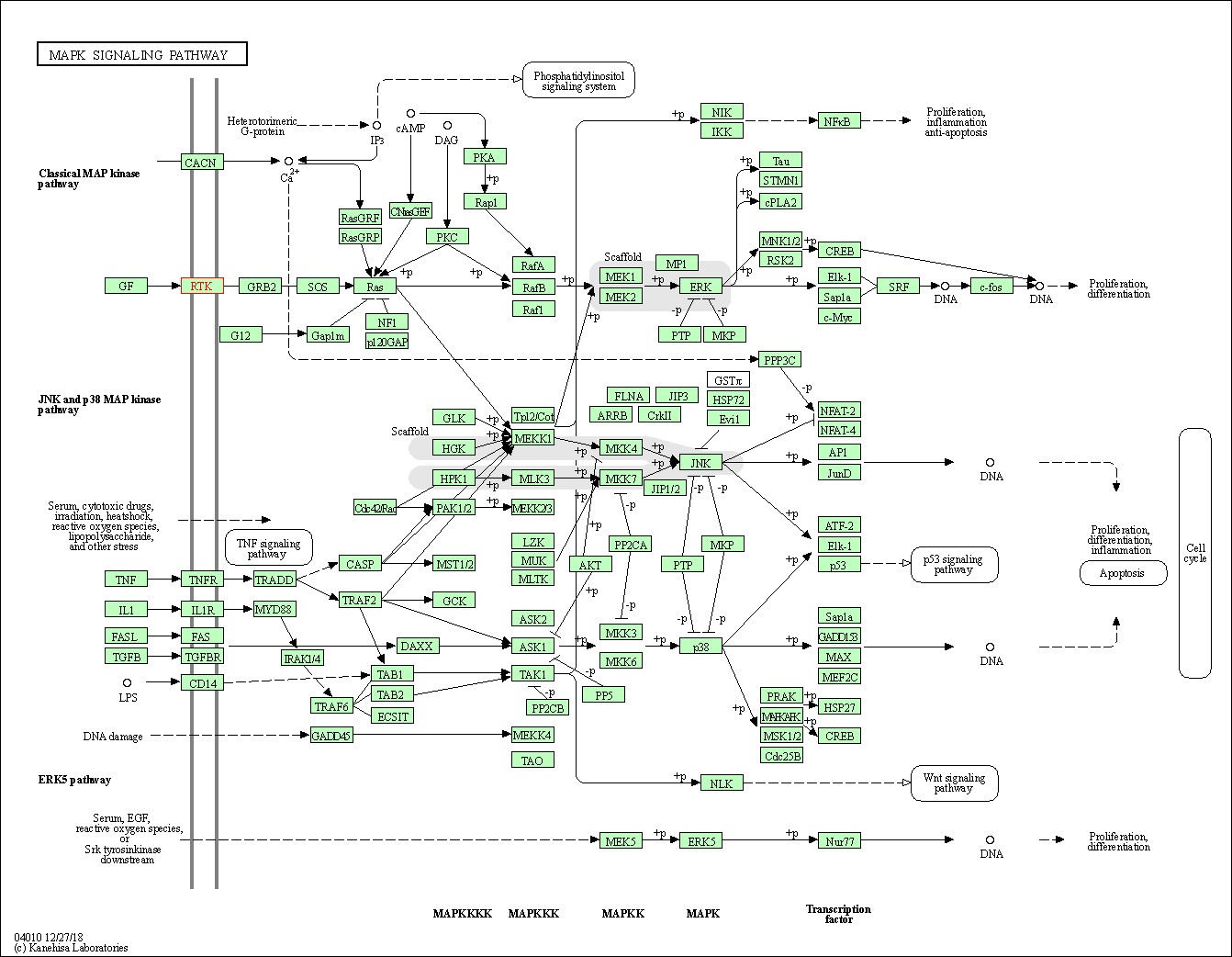
|
| Class: Environmental Information Processing => Signal transduction | Pathway Hierarchy | ||
| Ras signaling pathway | hsa04014 | Affiliated Target |
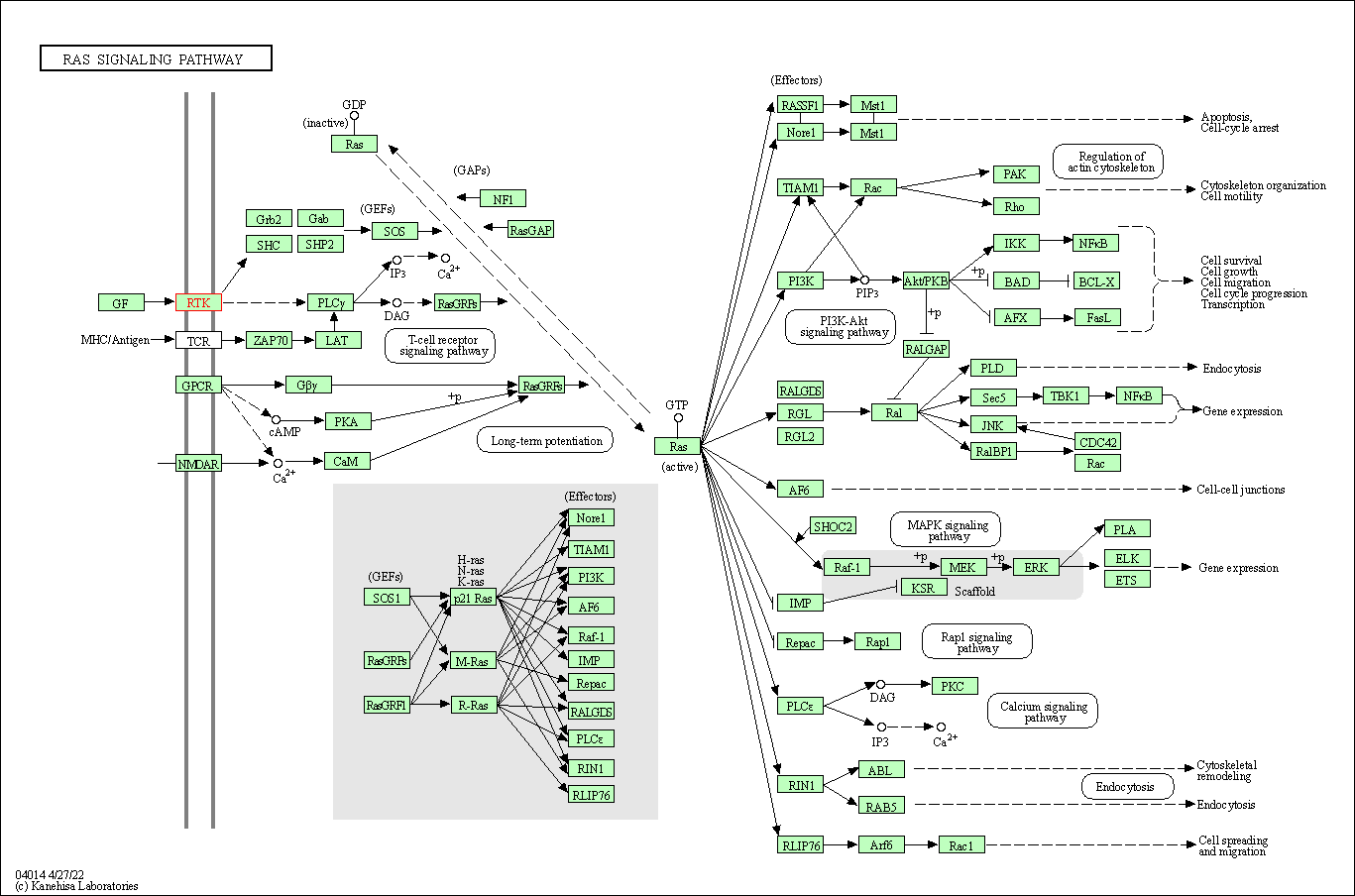
|
| Class: Environmental Information Processing => Signal transduction | Pathway Hierarchy | ||
| Rap1 signaling pathway | hsa04015 | Affiliated Target |

|
| Class: Environmental Information Processing => Signal transduction | Pathway Hierarchy | ||
| Calcium signaling pathway | hsa04020 | Affiliated Target |
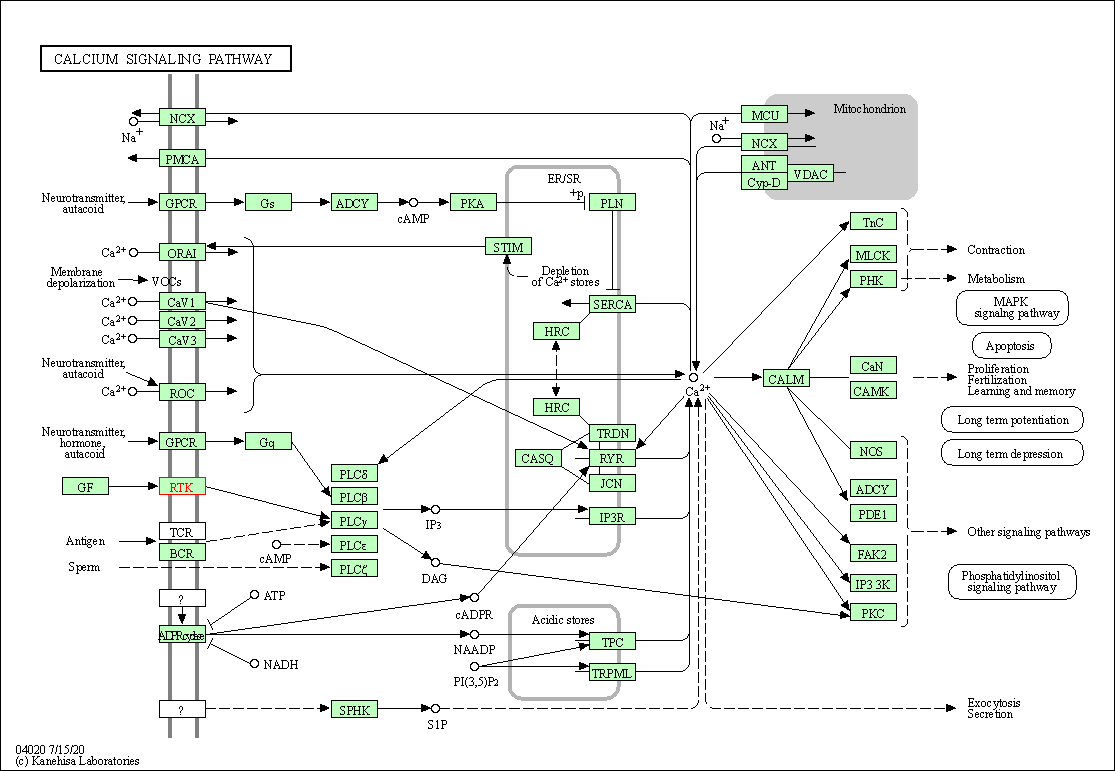
|
| Class: Environmental Information Processing => Signal transduction | Pathway Hierarchy | ||
| PI3K-Akt signaling pathway | hsa04151 | Affiliated Target |
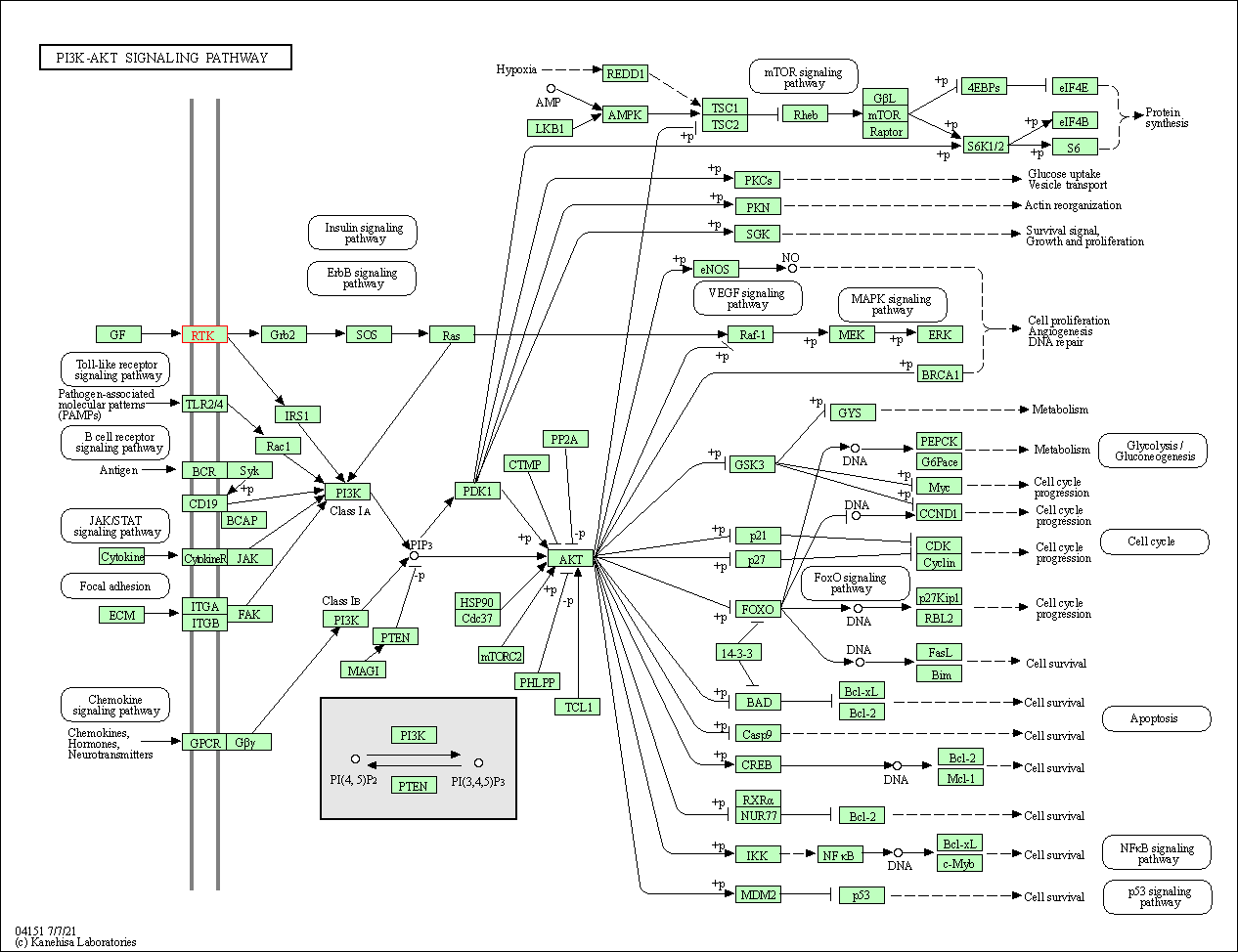
|
| Class: Environmental Information Processing => Signal transduction | Pathway Hierarchy | ||
| Adherens junction | hsa04520 | Affiliated Target |

|
| Class: Cellular Processes => Cellular community - eukaryotes | Pathway Hierarchy | ||
| Signaling pathways regulating pluripotency of stem cells | hsa04550 | Affiliated Target |

|
| Class: Cellular Processes => Cellular community - eukaryotes | Pathway Hierarchy | ||
| Thermogenesis | hsa04714 | Affiliated Target |
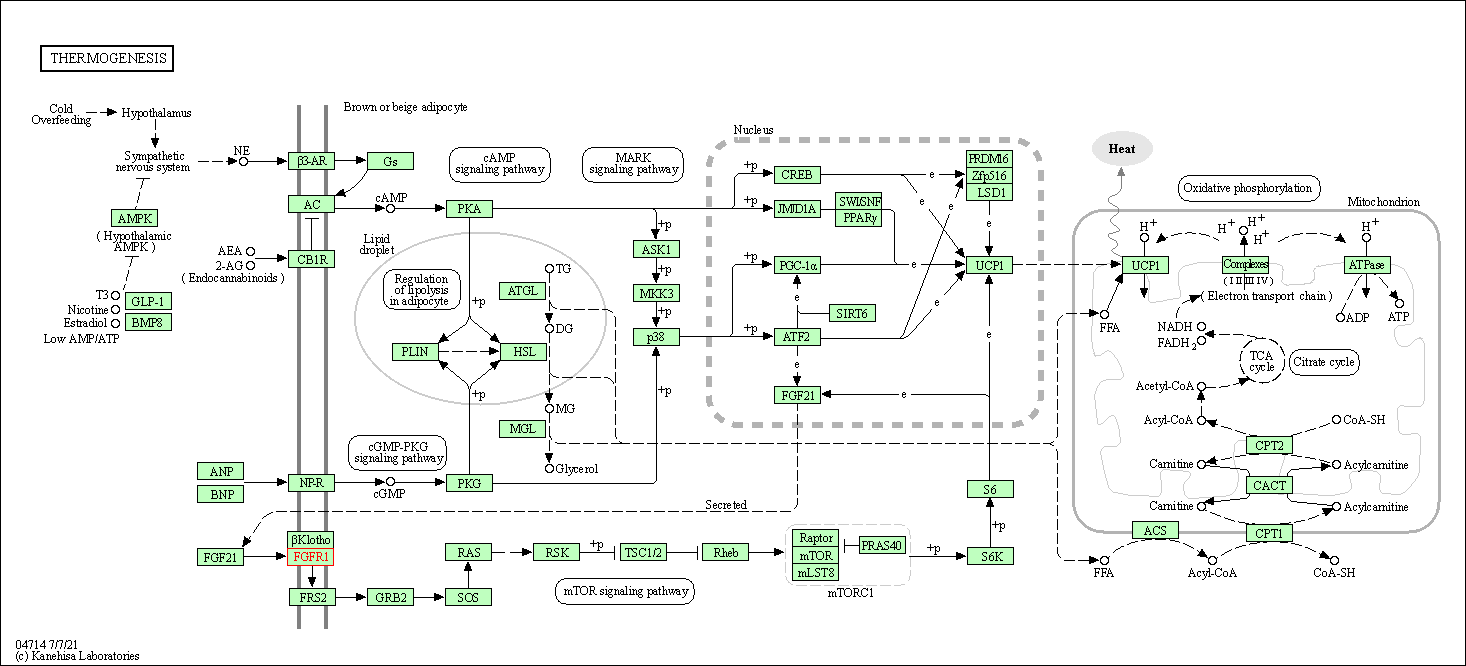
|
| Class: Organismal Systems => Environmental adaptation | Pathway Hierarchy | ||
| Regulation of actin cytoskeleton | hsa04810 | Affiliated Target |
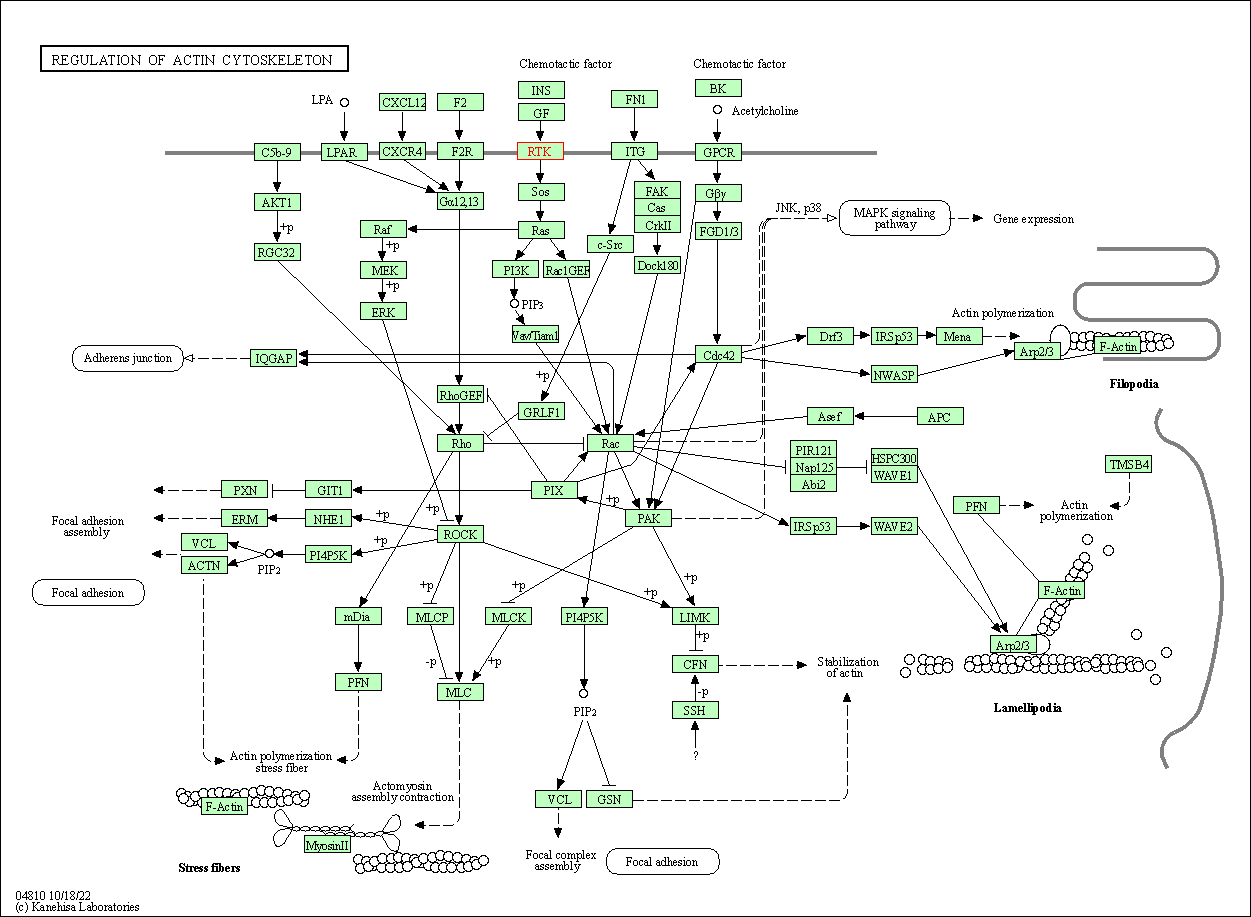
|
| Class: Cellular Processes => Cell motility | Pathway Hierarchy | ||
| Parathyroid hormone synthesis, secretion and action | hsa04928 | Affiliated Target |
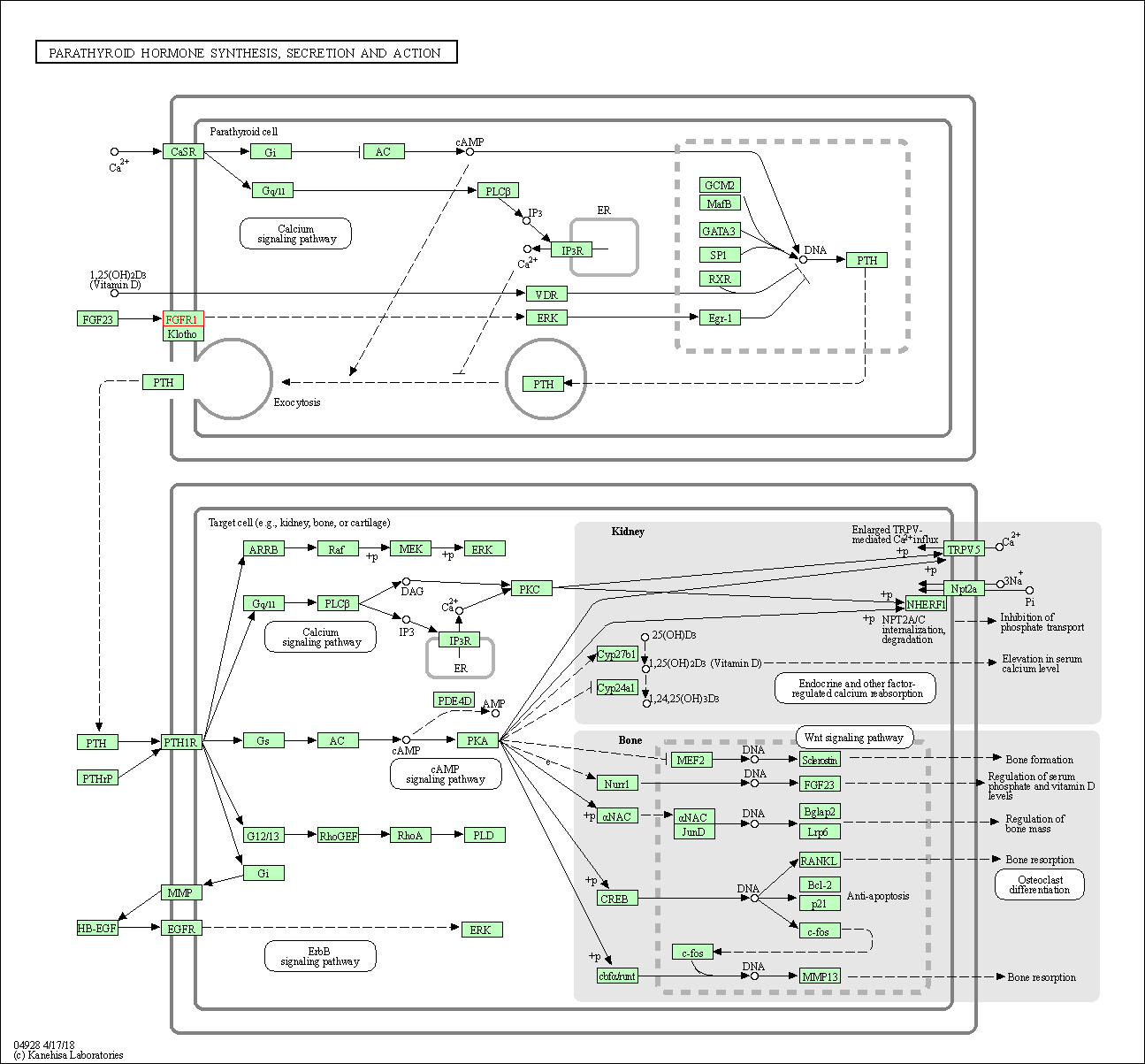
|
| Class: Organismal Systems => Endocrine system | Pathway Hierarchy | ||
| Click to Show/Hide the Information of Affiliated Human Pathways | |||
| Degree | 32 | Degree centrality | 3.44E-03 | Betweenness centrality | 2.14E-03 |
|---|---|---|---|---|---|
| Closeness centrality | 2.40E-01 | Radiality | 1.42E+01 | Clustering coefficient | 6.85E-02 |
| Neighborhood connectivity | 3.26E+01 | Topological coefficient | 6.34E-02 | Eccentricity | 12 |
| Download | Click to Download the Full PPI Network of This Target | ||||
| Chemical Structure based Activity Landscape of Target | Top |
|---|---|
| Drug Property Profile of Target | Top | |
|---|---|---|
| (1) Molecular Weight (mw) based Drug Clustering | (2) Octanol/Water Partition Coefficient (xlogp) based Drug Clustering | |
|
|
||
| (3) Hydrogen Bond Donor Count (hbonddonor) based Drug Clustering | (4) Hydrogen Bond Acceptor Count (hbondacc) based Drug Clustering | |
|
|
||
| (5) Rotatable Bond Count (rotbonds) based Drug Clustering | (6) Topological Polar Surface Area (polararea) based Drug Clustering | |
|
|
||
| "RO5" indicates the cutoff set by lipinski's rule of five; "D123AB" colored in GREEN denotes the no violation of any cutoff in lipinski's rule of five; "D123AB" colored in PURPLE refers to the violation of only one cutoff in lipinski's rule of five; "D123AB" colored in BLACK represents the violation of more than one cutoffs in lipinski's rule of five | ||
| Co-Targets | Top | |||||
|---|---|---|---|---|---|---|
| Co-Targets | ||||||
| Target Poor or Non Binders | Top | |||||
|---|---|---|---|---|---|---|
| Target Poor or Non Binders | ||||||
| Target Regulators | Top | |||||
|---|---|---|---|---|---|---|
| Target-regulating microRNAs | ||||||
| Target-interacting Proteins | ||||||
| Target Profiles in Patients | Top | |||||
|---|---|---|---|---|---|---|
| Target Expression Profile (TEP) | ||||||
| Drug Resistance Mutation (DRM) | ||||||
| Target-Related Models and Studies | Top | |||||
|---|---|---|---|---|---|---|
| Target Validation | ||||||
| Target QSAR Model | ||||||
| References | Top | |||||
|---|---|---|---|---|---|---|
| REF 1 | Anthranilic acid amides: a novel class of antiangiogenic VEGF receptor kinase inhibitors. J Med Chem. 2002 Dec 19;45(26):5687-93. | |||||
| REF 2 | 2014 FDA drug approvals. Nat Rev Drug Discov. 2015 Feb;14(2):77-81. | |||||
| REF 3 | Drugs@FDA. U.S. Food and Drug Administration. U.S. Department of Health Human Services. 2020 | |||||
| REF 4 | URL: http://www.guidetopharmacology.org Nucleic Acids Res. 2015 Oct 12. pii: gkv1037. The IUPHAR/BPS Guide to PHARMACOLOGY in 2016: towards curated quantitative interactions between 1300 protein targets and 6000 ligands. (Ligand id: 6974). | |||||
| REF 5 | 2008 FDA drug approvals. Nat Rev Drug Discov. 2009 Feb;8(2):93-6. | |||||
| REF 6 | Clinical pipeline report, company report or official report of the Pharmaceutical Research and Manufacturers of America (PhRMA) | |||||
| REF 7 | URL: http://www.guidetopharmacology.org Nucleic Acids Res. 2015 Oct 12. pii: gkv1037. The IUPHAR/BPS Guide to PHARMACOLOGY in 2016: towards curated quantitative interactions between 1300 protein targets and 6000 ligands. (Ligand id: 7649). | |||||
| REF 8 | ClinicalTrials.gov (NCT02135107) A Double-blind Comparative Study of the Efficacy and Safety of E3810 10mg Once and Twice Daily in Maintenance Therapy for PPI Resistant Gastroesophageal Reflux Disease Patients. U.S. National Institutes of Health. | |||||
| REF 9 | ClinicalTrials.gov (NCT00499707) Efficacy and Safety Study of Rosiglitazone/Metformin Therapy vs Rosiglitazone and Metformin in Type 2 Diabetes Subjects. U.S. National Institutes of Health. | |||||
| REF 10 | ClinicalTrials.gov (NCT02589821) Phase III Study of Surufatinib in Treating Advanced Pancreatic Neuroendocrine Tumors. U.S. National Institutes of Health. | |||||
| REF 11 | URL: http://www.guidetopharmacology.org Nucleic Acids Res. 2015 Oct 12. pii: gkv1037. The IUPHAR/BPS Guide to PHARMACOLOGY in 2016: towards curated quantitative interactions between 1300 protein targets and 6000 ligands. (Ligand id: 7707). | |||||
| REF 12 | ClinicalTrials.gov (NCT02154490) Lung-MAP: S1400 Biomarker-Targeted Second-Line Therapy in Treating Patients With Recurrent Stage IIIB-IV Squamous Cell Lung Cancer. U.S. National Institutes of Health. | |||||
| REF 13 | ClinicalTrials.gov (NCT01938599) Study Comparing AM001 Cream to Vehicle in the Treatment of Plaque Psoriasis. U.S. National Institutes of Health. | |||||
| REF 14 | ClinicalTrials.gov (NCT03834220) Basket Trial in Solid Tumors Harboring a Fusion of FGFR1, FGFR2 or FGFR3- (FUZE Clinical Trial). U.S. National Institutes of Health. | |||||
| REF 15 | URL: http://www.guidetopharmacology.org Nucleic Acids Res. 2015 Oct 12. pii: gkv1037. The IUPHAR/BPS Guide to PHARMACOLOGY in 2016: towards curated quantitative interactions between 1300 protein targets and 6000 ligands. (Ligand id: 4923). | |||||
| REF 16 | ClinicalTrials.gov (NCT01244438) Study of FP-1039 in Subjects With Endometrial Cancers. U.S. National Institutes of Health. | |||||
| REF 17 | ClinicalTrials.gov (NCT04583423) A Phase 2b Randomized, Double-Blind, Placebo-Controlled Study to Evaluate the Efficacy and Safety of MK-3655 in Individuals With Pre-cirrhotic Nonalcoholic Steatohepatitis. U.S.National Institutes of Health. | |||||
| REF 18 | MK-2461, a novel multitargeted kinase inhibitor, preferentially inhibits the activated c-Met receptor. Cancer Res. 2010 Feb 15;70(4):1524-33. | |||||
| REF 19 | URL: http://www.guidetopharmacology.org Nucleic Acids Res. 2015 Oct 12. pii: gkv1037. The IUPHAR/BPS Guide to PHARMACOLOGY in 2016: towards curated quantitative interactions between 1300 protein targets and 6000 ligands. (Ligand id: 5691). | |||||
| REF 20 | KW-2449, a novel multikinase inhibitor, suppresses the growth of leukemia cells with FLT3 mutations or T315I-mutated BCR/ABL translocation. Blood. 2009 Aug 20;114(8):1607-17. | |||||
| REF 21 | Clinical pipeline report, company report or official report of the Pharmaceutical Research and Manufacturers of America (PhRMA) | |||||
| REF 22 | Trusted, scientifically sound profiles of drug programs, clinical trials, safety reports, and company deals, written by scientists. Springer. 2015. Adis Insight (drug id 800022289) | |||||
| REF 23 | Trusted, scientifically sound profiles of drug programs, clinical trials, safety reports, and company deals, written by scientists. Springer. 2015. Adis Insight (drug id 800014130) | |||||
| REF 24 | URL: http://www.guidetopharmacology.org Nucleic Acids Res. 2015 Oct 12. pii: gkv1037. The IUPHAR/BPS Guide to PHARMACOLOGY in 2016: towards curated quantitative interactions between 1300 protein targets and 6000 ligands. (Target id: 1808). | |||||
| REF 25 | E-3810 is a potent dual inhibitor of VEGFR and FGFR that exerts antitumor activity in multiple preclinical models. Cancer Res. 2011 Feb 15;71(4):1396-405. | |||||
| REF 26 | A comparison of physicochemical property profiles of marketed oral drugs and orally bioavailable anti-cancer protein kinase inhibitors in clinical development. Curr Top Med Chem. 2007;7(14):1408-22. | |||||
| REF 27 | Dose-finding study of the multitargeted tyrosine kinase inhibitor SU6668 in patients with advanced malignancies. Clin Cancer Res. 2005 Sep 1;11(17):6240-6. | |||||
| REF 28 | Clinical pipeline report, company report or official report of Hutchison Medi Pharma. | |||||
| REF 29 | AZD4547: an orally bioavailable, potent, and selective inhibitor of the fibroblast growth factor receptor tyrosine kinase family. Cancer Res. 2012 Apr 15;72(8):2045-56. | |||||
| REF 30 | Trusted, scientifically sound profiles of drug programs, clinical trials, safety reports, and company deals, written by scientists. Springer. 2015. Adis Insight (drug id 800029917) | |||||
| REF 31 | Marimastat as maintenance therapy for patients with advanced gastric cancer: a randomised trial. Br J Cancer. 2002 Jun 17;86(12):1864-70. | |||||
| REF 32 | FGF1-gold nanoparticle conjugates targeting FGFR efficiently decrease cell viability upon NIR irradiation. Int J Nanomedicine. 2012; 7: 5915-5927. | |||||
| REF 33 | Non-Alcoholic Steatohepatitis (NASH) - A Review of a Crowded Clinical Landscape, Driven by a Complex Disease. Drug Des Devel Ther. 2021 Sep 22;15:3997-4009. | |||||
| REF 34 | Discovery and evaluation of 4-(2-(4-chloro-1H-pyrazol-1-yl)ethylamino)-3-(6-(1-(3-fluoropropyl)piperidin-4-yl)-4-methyl-1H-benzo[d]imidazol-2-yl)py... J Med Chem. 2008 Oct 9;51(19):5897-900. | |||||
| REF 35 | Pyrido[2,3-d]pyrimidin-7-one inhibitors of cyclin-dependent kinases. J Med Chem. 2000 Nov 30;43(24):4606-16. | |||||
| REF 36 | Design and structure-activity relationship of 3-benzimidazol-2-yl-1H-indazoles as inhibitors of receptor tyrosine kinases. Bioorg Med Chem Lett. 2006 Jul 1;16(13):3595-9. | |||||
| REF 37 | The Protein Data Bank. Nucleic Acids Res. 2000 Jan 1;28(1):235-42. | |||||
| REF 38 | Design, structure-activity relationships and in vivo characterization of 4-amino-3-benzimidazol-2-ylhydroquinolin-2-ones: a novel class of receptor... J Med Chem. 2009 Jan 22;52(2):278-92. | |||||
| REF 39 | Biochemical and cellular effects of c-Src kinase-selective pyrido[2, 3-d]pyrimidine tyrosine kinase inhibitors. Biochem Pharmacol. 2000 Oct 1;60(7):885-98. | |||||
| REF 40 | 5-Substituted pyrido[2,3-d]pyrimidine, an inhibitor against three receptor tyrosine kinases. Bioorg Med Chem Lett. 2009 Feb 1;19(3):745-50. | |||||
| REF 41 | The design, synthesis, and biological evaluation of potent receptor tyrosine kinase inhibitors. Bioorg Med Chem Lett. 2012 Aug 1;22(15):4979-85. | |||||
| REF 42 | Discovery of Disubstituted Imidazo[4,5-b]pyridines and Purines as Potent TrkA Inhibitors. ACS Med Chem Lett. 2012 Jul 26;3(9):705-9. | |||||
| REF 43 | Design, synthesis and biological evaluation of novel FGFR inhibitors bearing an indazole scaffold. Org Biomol Chem. 2015 Jul 28;13(28):7643-54. | |||||
| REF 44 | Biological evaluation of a multi-targeted small molecule inhibitor of tumor-induced angiogenesis. Bioorg Med Chem Lett. 2006 Apr 1;16(7):1950-3. | |||||
| REF 45 | Characterization of the cholangiocarcinoma drug pemigatinib against FGFR gatekeeper mutants. Commun Chem. 2022 Aug 22;5(1):100. | |||||
| REF 46 | Landscape of activating cancer mutations in FGFR kinases and their differential responses to inhibitors in clinical use. Oncotarget. 2016 Apr 26;7(17):24252-68. | |||||
If You Find Any Error in Data or Bug in Web Service, Please Kindly Report It to Dr. Zhou and Dr. Zhang.

